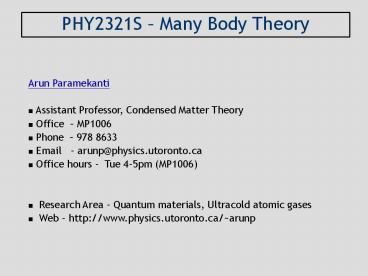PHY2321S Many Body Theory - PowerPoint PPT Presentation
1 / 13
Title:
PHY2321S Many Body Theory
Description:
3. Quantum Ising model: path integral, duality, quantum phase transition ... 10. Duality for bosons. 11. Fermionic path integral. 12. Free fermi gas using path ... – PowerPoint PPT presentation
Number of Views:169
Avg rating:3.0/5.0
Title: PHY2321S Many Body Theory
1
PHY2321S Many Body Theory
- Arun Paramekanti
- Assistant Professor, Condensed Matter Theory
- Office MP1006
- Phone 978 8633
- Email - arunp_at_physics.utoronto.ca
- Office hours - Tue 4-5pm (MP1006)
- Research Area - Quantum materials, Ultracold
atomic gases - Web - http//www.physics.utoronto.ca/arunp
2
What is condensed matter physics?
- Traditionally Solid State Physics was a
distinct discipline in the 1930s-60s - from liquid state, low temperature
physics - Condensed matter grew in the 1960s
solid state is the major subfield - 2006 Wikipedia - the field of physics that deals
with the macroscopic properties of matter - Encompasses a rich variety of systems
- - Solid state materials semiconductors,
superconductors, magnets, - - Ultracold atomic condensates
- - Helium fluids (superfluids)
- - Colloids
- - Polymers
- - Liquid crystals
- - Granular systems
3
What is condensed matter physics?
- Common themes
- Ingredients
- - Many particles (electrons, atoms,
sand grains, liquid crystal molecules) - - Interactions (Coulomb, van der
Waals, hard core, dipolar) - Effects
- - Collective macroscopic behavior,
not contained in single particles - Sum is more than its parts
- More is different Philip W.
Anderson (Science, 1977) - Universe in a Helium droplet
G. E. Volovik (2004) - Not common themes
- - Is quantum mechanics important?
(We will focus on such systems) - - Classical behavior?
- - Is energy conserved? Dissipation?
4
Quantum many body theory
The study of collective macroscopic phenomena
arising from - Many identical
particles - Interactions -
Quantum mechanics Questions Why do a bunch
of interacting bosons exhibit dissipationless
flow? Why do interacting
spins act collectively to flip their state?
Why do interacting electrons
exhibit collective oscillations?
Do particle-like excitations even exist in
interacting Fermi fluids?
Techniques Quantum field theory (2nd
quantization, Path integrals, Diagrams)
Variational wavefunctions (We will not
explore this much)
5
Outline
0. Overview of the course, systems,
experimental probes 1. First quantization,
second quantization 2. Models of interest for
spins, bosons, fermions 3. Quantum Ising model
path integral, duality, quantum phase
transition 4. d-dimensional quantum
(d1)-dimensional classical 5. The harmonic
oscillator path integral 6. Coherent state path
integral for the harmonic oscillator 7. Weakly
interacting Bose gas Bogoliubov theory 8.
Weakly interacting Bose gas Path integral
analysis 9. Mott insulators and superfluid-Mott
transition 10. Duality for bosons 11. Fermionic
path integral 12. Free fermi gas using path
integrals 13. Interacting Fermi gas Large-N
approach 14. Collective excitations, Self
energy, Fermi liquid theory 15. Breakdown of
Fermi liquid theory in 1D and for graphene
6
Ultracold atomic condensates
Single atomic species - K, Na, Rb,
LiBosons/FermionsCool down to
microkelvinImpose optical lattice
- Bose Einstein condensation (Joseph Thywissen
group)
Simple constituents, yet rich behaviorEnergy
scale 0.1 - 1 mK (degeneracy temperature)
7
High temperature superconductivity
- CuO2 layers- Spaced apart by insulating
layers- Conduction in the 2D plane- Tc 50-150K
La2-xSrxCuO4
Looks complex, yet rich behavior arises from 2D
CuO2 planesEnergy scale 500K (magnetism), 100K
(superconductivity)
8
Graphene room temperature quantum Hall effect
Experimental example of 2D interacting Dirac
fermionsEnergy scale 300K (quantum Hall effect)
9
Spectroscopy, transport
Neutrons 1meV 500 meV (spin
dynamics, phonons)X-rays 1-20
eV (crystal structure, electronic
excitations)Photoemission 1meV 1eV
(single particle spectrum)Electrodynamics
Microwave Optical (meV eV)Tunneling
Scanning tunneling spectroscopyElec.
Resistance Temperature and magnetic field
dependenceTher. Resistance Heat transport
10
Books and online references
1. L. P. Pitaevskii and S. Stringari
Bose Einstein Condensation (Oxford) 2. A.
Auerbach Interacting electrons and quantum
magnetism (Springer) 3. J.W. Negele and H.
Orland Quantum many particle systems
(Harper Collins) 4. P. Coleman Online
- http//www.physics.rutgers.edu/coleman/mbody/pd
f/bk.pdf
11
Quantum many body theory
EVALUATION 1. Problem sets 80 2.
Final Exam 20
12
Research in strongly correlated quantum
materials at UofT
Experiments Stephen Julian Quantum criticality
in metals, measuring Fermi surfaces
-- high pressure, high B fields, mK
studies Young-June Kim Quantum magnetism,
charge ordering --
neutron scattering, Xray scattering,
ellipsometry/optics John Wei Unconventional
superconductivity, heavy fermions,
nanostructures -- point contact
spectroscopy, STM 2007 New faculty hire in
progress in broadly related area
13
Research in strongly correlated quantum
materials at UofT
Theory Hae-Young Kee Electronic liquid
crystals, frustrated magnetism,
superconductivity --
mean field theory, fluctuations,
phenomenology Yong-Baek Kim Quantum magnetism,
nonequilibrium physics, quantum phase
transitions gauge theories,
nonequilibrium field theories,
renormalization group Arun Paramekanti
High temperature superconductors, spectroscopies
of strongly
correlated systems, ultracold atomic gases
field theory,
numerical Monte Carlo methods, renormalization
group































